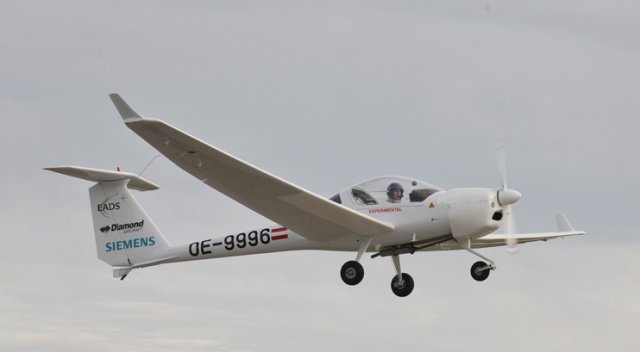 Last month Siemens and EADS demonstrated a new gas-electric vehicle capable of carrying two people and their luggage 900 kilometers—roughly the distance from New York to Detroit—between refuels and recharges. The prototype was not a car, but a small two-seater airplane.
Last month Siemens and EADS demonstrated a new gas-electric vehicle capable of carrying two people and their luggage 900 kilometers—roughly the distance from New York to Detroit—between refuels and recharges. The prototype was not a car, but a small two-seater airplane.
The hybrid plane is similar to the Chevrolet Volt in that it relies on an electric motor and uses a gas engine as backup. The airplane matches the performance of some private airplanes already on the market, but it has two distinct advantages: it’s remarkably quiet, and uses about 25 percent less fuel.
The achievement presages what is likely to be a big shift toward hybrid propulsion in airplanes. Several major corporations envision a future in which airplanes rely at least in part on electric propulsion. Although the technology will be applied to small planes at first, eventually it could help reduce noise and emissions from airliners.
“Within this decade, we will certainly see hybrid electric aircraft entering the market,” says Frank Anton, who heads the hybrid aircraft efforts at Siemens. Four-seat hybrid aircraft are likely within that time frame, he says, but even 19 seaters are possible before the decade is out. Anton predicts that eventually we will see 100-passenger hybrid aircraft that use half as much fuel as today’s airplanes.
Boeing is taking this a step further with a concept for hybrid airplanes the size of 737s, which can seat more than 150 passengers, although it’s unlikely these will come into service before 2030. EADS, the parent company of Airbus, has also developed a conceptual design for passenger airplanes that fly exclusively on electricity, although the range of these aircraft would be limited.
“A few years ago, the idea of flying an airplane on batteries was a joke,” says Marty Bradley, a principle investigator for advanced aircraft concepts at Boeing Research and Technology. While batteries and electric motors are efficient and quiet, batteries tend to be big and heavy, storing far less energy than liquid fuels.
Two things have changed. The amount of energy that batteries can store is steadily improving, and this looks likely to continue as they’re developed for use in portable electronics and electric vehicles, Bradley says. Meanwhile, the technologies needed to integrate batteries and electric motors with conventional engines are getting smaller, lighter, and more efficient. Siemens demonstrated an earlier version of its hybrid airplane in 2011, but it was too heavy to be practical. For the new plane, Siemens decreased the weight of the electric motor, power electronics, and gears by 100 kilograms to bring its cargo and passenger capacity up to the level of similarly sized small planes.
In airplanes, a hybrid electric design improves efficiency mainly by making it possible to use a relatively small gas-powered engine designed to run at its most efficient at cruising speeds. The battery and electric motor provide the extra power needed for takeoff and ascent. The batteries also make it possible to recover energy during descent much the way hybrid cars capture energy during braking (propellers spin a generator). And, as batteries improve, they will provide more and more of the energy on board.
Electric motors confer other advantages. They can be mounted in unusual places on an airplane, which can be used to improve aerodynamics. They can also be steered: angled upward, for example, during takeoff to get a plane off the ground faster. In flight, the motor could be pointed left or right to steer the plane, eliminating the need for a rudder. These design changes, together with the efficiency of the hybrid propulsion, could help decrease fuel consumption by half, he says (see “‘Hybrid Wing’ Uses Half the Fuel of a Standard Airplane”).
How fast electric propulsion is adopted depends mostly on the development of the batteries. EADS’s electric airplane plans call for a battery that can store 1,000 watt hours per kilogram, which is about five times more energy than a typical lithium-ion battery. New battery chemistries like lithium-air and lithium-sulfur could provide more capacity, but some big challenges remain (see “Nanostructures Boost Battery Life Fivefold” and “Beyond Lithium Ion: ARPA-E Places Bets on Novel Energy Storage”). Bradley expects that all-electric aircraft will be limited to 1,600 kilometers until after 2050.
For larger aircraft, electric propulsion might be used to help spin the large turbofans on the front of a jet engine. The first application of electric propulsion for large planes will be for taxiing, allowing planes to save fuel on the ground, he says.
So for the next several years hybrid technology will be limited to small planes. One near-term benefit of the technology is that small airports (which are often located near residential areas) will be quieter, says Jean Koster, a professor of aerospace engineering sciences at the University of Colorado at Boulder who has founded a company to commercialize a more compact gearbox for combining gas and electric power. Hybrid designs could also put an end to one of the last holdouts of fuel that contains lead: small airplanes with high compression engines still require lead additives. In fact, the battery boost could make it possible to use the same gas-powered engines used in hybrid cars.
Source: MIT Technology Review
